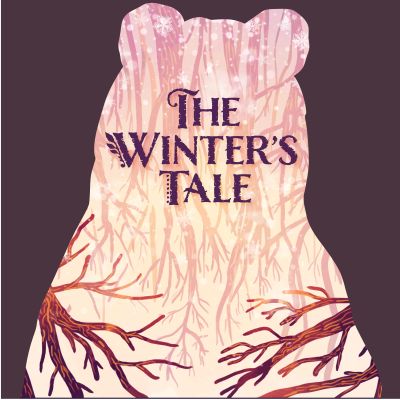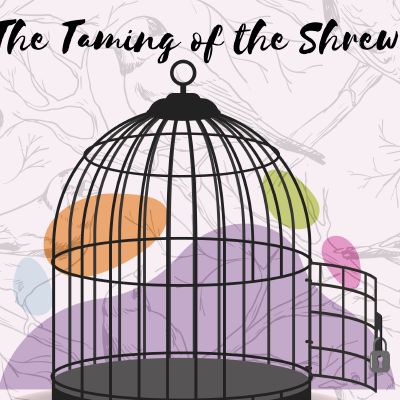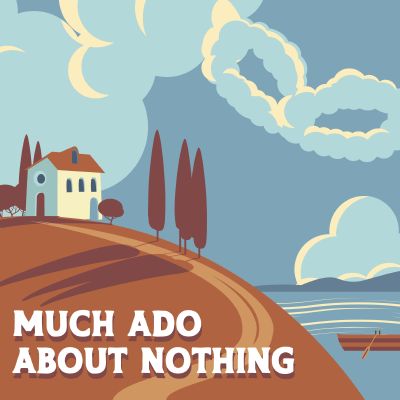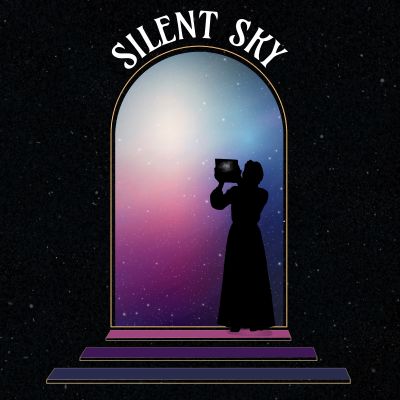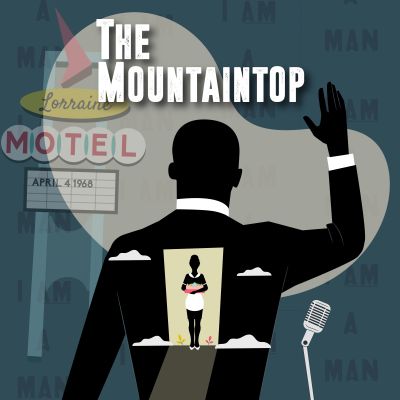News From the Festival
The Creative Process: Festival Reveals 2024 Show Art
The Utah Shakespeare Festival is delighted to share this season’s show art. We’ve officially pulled back the curtain to give you a sneak peek of what to expect visually from our upcoming season, so enjoy the reveal!
For Creative Director Clare Campbell, this is one of her biggest––and most rewarding––projects of the year.
However, the job isn’t without its challenges, and Campbell explained that each year requires an immense amount of collaboration and research.
The process of designing show art is a big one, and it begins with Campbell studying the scripts and attending designer meetings to gain insight about the directors’ and designers’ ideas for each play. But it’s also important to note that the art doesn’t necessarily represent each of the productions literally.
“The goal [for the show art] is for anyone to look at the graphic and get the concept and tone of the play, as well as be intrigued at the same time,” Campbell said. “We don’t want to give anything away, but still include subtle hints and Easter eggs.”
Campbell creates individual designs for each play with the entirety of the season lineup in mind.
“It’s kind of a puzzle, you’re working on one play graphic, but you have the other six or seven plays you have to match, including the Greenshow,” Campbell said. “They all have to have a cohesive look.”
After months of work, the Festival is proud and excited to share the first reveal of the Show Art and hope that it does just as Campbell hopes––to intrigue and encourage our patrons to join us for the 2024 season.
It’s not too early to purchase tickets. The play lineup for the 63rd season includes Shakespeare’s Henry VIII, The Winter’s Tale, The Taming of the Shrew, and Much Ado About Nothing, along with the hilarious The 39 Steps, the moving Silent Sky, and the inspirational The Mountaintop.
The season runs June 17 through October 5.
The Taming of the Shrew: 10 Fun Facts

One of Shakespeare’s first comedies, The Taming of the Shrew is one of his most famous—and deemed one of his most problematic—plays. Although difficult themes are discussed, Director Valerie Rachelle is approaching the play with color, fun, and comedy. Ultimately, this Festival production will use farce and slapstick comedy, and focus on how to treat others better.
-
Did you know The Taming of the Shrew is actually a play-within-a-play? Although most productions don’t include the induction at the beginning that creates this metadrama, Rachelle will be including it this season.
-
Rachelle is also taking the liberty to book-end the play with a more complete ending and bring the induction full-circle, as many claim this play by Shakespeare was unfinished because he left off the epilogue.
-
A lot of contemporary theatres choose to not produce this play because of its difficult themes. Rachelle, however, believes it teaches an important lesson if approached correctly. “It’s showing us what not to do, rather than what to do,” Rachelle said.

2024 Production Renderings: costume designs by Kevin Alberts. -
The play was popular during Shakespeare’s time, and a response to The Taming of the Shrew was written in 1611, nearly 20 years later. John Fletcher wrote The Woman’s Prize, or The Tamer Tamed, which tells the story of Petruchio marrying again, only to find the roles reversed as his new wife takes control of their marriage. In 1633, both plays were performed for King Charles I and were well-liked.
-
Unfortunately, Shakespeare gained inspiration for the play from popular folktales and ballads in England about wives being tamed by their aggressive husbands, which was a common practice in Elizabethan England.
-
The playwright may have also gained inspiration from Ludovico Ariosto’s Suppositi (1509) and George Gascoigne’s Supposes (1566).
-
Although not a musical, Sound Designer Lindsay Jones is creating new music for the production—a new addition that patrons familiar with the play can look forward to.

2024 Production Renderings: costume designs by Kevin Alberts. -
The play has been adapted many times. Some of the most well-known adaptations include Cole Porter’s musical Kiss Me, Kate!; McLintock!, a western starring John Wayne, and the 1967 film starring Elizabeth Taylor and Richard Burton.
-
Rachelle can do it all! Last season, she directed the immensely sweet and clever Jane Austen’s Emma The Musical in the Randall L. Jones Theatre. This season, she’s pivoting to a Shakespeare comedy and is producing in the outdoor space of the Engelstad Shakespeare Theare.
-
This is the Festival’s 11th production of the play, with the first being in 1962 and the most recent prior to this season in 2015.
Remember, it’s not too early to purchase tickets! Visit bard.org for tickets and more information about the play. Don’t miss out on our study guide, where you can find a synopsis, character summaries, and several articles on the play.
The Taming of the Shrew Through the Years
This is the 11th Utah Shakespeare Festival production of The Taming of the Shrew.
Shakespeare’s play was part of the very first season in 1962, and then hit the Festival stages again in 1966, 1971, 1977, 1984, 1991, 1998, 2004, 2008, and most recently in 2015. Take a walk down memory lane and enjoy these pictures of some of our past productions!
And don’t forget to purchase tickets to our 2024 production by visiting bard.org.
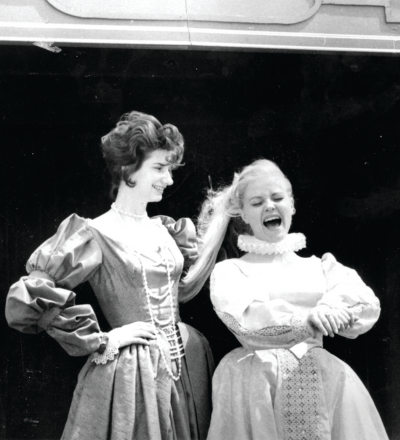
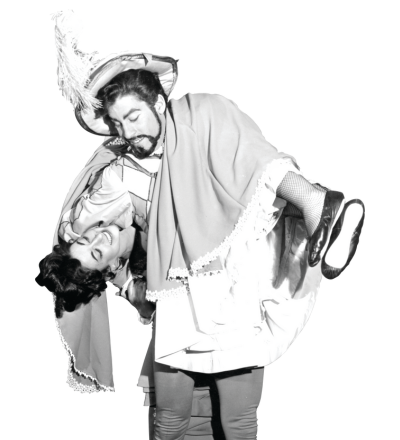
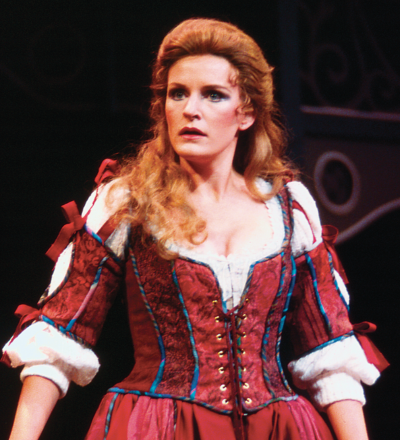
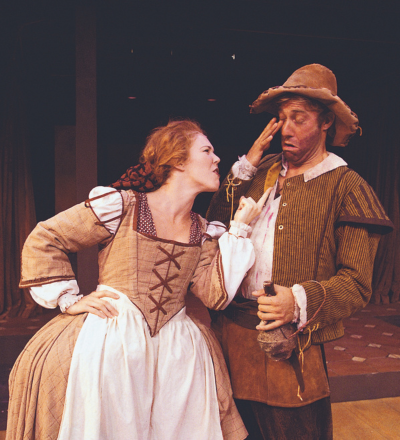
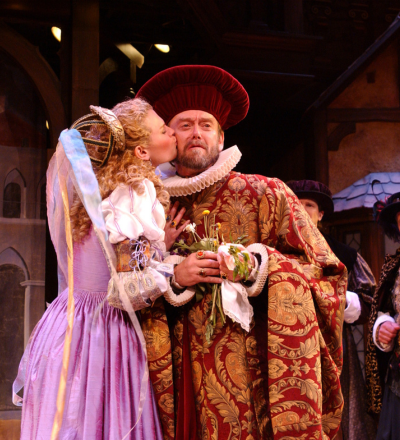
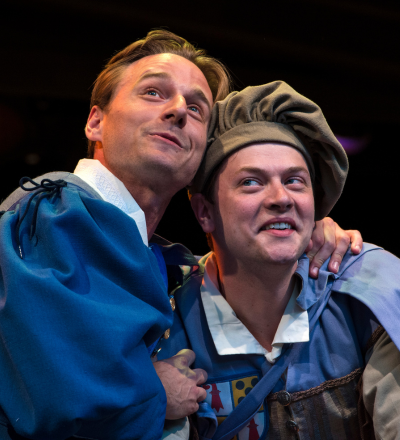
Educational Offerings for School Groups: Shakespearience and Free USF School Days

Educating and inspiring theatre lovers is a huge part of the Festival’s mission, and this often begins with young thespians. Shakespearience and USF School Days are a must!
Education Director Katherine Norman explains the differences between the two offerings.
“Shakespearience offers discounted tickets for any Monday through Friday matinee in August and September. The tickets include awesome extras like workshops, tours, and talkbacks just for your students,” Norman said.
USF School Days, on the other hand, are two specific free performances set aside for Utah public and public charter school groups.
Shakespearience
Monday through Friday Matinees, August and September, 2024
Schools and education groups can enjoy a professional play, orientation, and other experiences with the Festival’s Shakespearience program for just $10 a person.
The experience offers access to study guide materials that extend learning in classrooms, and the option to schedule personalized talkbacks, workshops, or art center tours for schools. For more information, click here.
USF School Days - FREE!
September 5, 2024 - Much Ado About Nothing at 2 p.m.
September 11, 2024 - Silent Sky at 2 p.m.
Utah public and public charter school groups can attend these matinees of Much Ado About Nothing and Silent Sky for free thanks to funding from the state’s POPS program. For more information, click here.
To book Shakespearience and USF School Days tickets, call the ticket office at 800-PLAYTIX. Questions for the Education Department? Call 435-865-8333 or email usfeducation@bard.org.
It’s not too early to purchase tickets for the 2024 season of the Utah Shakespeare Festival. The play lineup for the 63rd season includes Shakespeare’s Henry VIII, The Winter’s Tale, The Taming of the Shrew, and Much Ado About Nothing, along with the hilarious The 39 Steps, the moving Silent Sky, and the inspirational The Mountaintop. The season runs June 17 through October 5.
What to Know About The 39 Steps: 10 Fun Facts About the Comedy

The Utah Shakespeare Festival is thrilled to have The 39 Steps in our 2024 play lineup. A thrilling comedy that blends farce, suspense, and romance, this play is a must-see for patrons in the upcoming season. Before you attend the theatre, here are some fun things you may want to know about this show.
-
Director Aaron Galligan-Stierle was in the Festival’s first and most recent production of The 39 Steps. This season, he will be directing the play. In 2010, he played the role of one of the two clowns.
“I am thrilled to bring with me many lessons from that production as well as rediscover, reinvent, and reconsider many of the elements with a new team of collaborators,” Galligan-Stierle recently said.
-
The 39 Steps started as a novel written in 1915 by John Buchan and has since inspired many a mystery story. Later, it became an Alfred Hitchcock film in 1935, and the British Film Institute named it the fourth greatest British film of all time.
-
The play has been adapted for the screen three times, and, announced in 2021, is set to be adapted as a limited series on Netflix starring Benedict Cumberbatch.
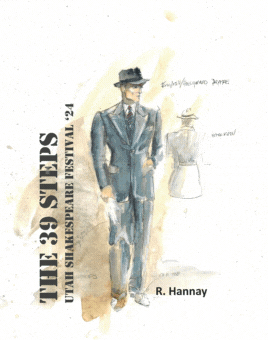
2024 Costume Renderings by Matthew Pedersen. -
Because the play follows an innocent man accused of a crime, this was the first of many of Hitchcock’s films that followed the “wrong man” theme.
-
Galligan-Stierle is using the inspiration of film noir, and hopes audience members will feel as if they’re in a movie theatre, “but somehow experiencing something so much better than a movie by using theatrical conventions and stage magic to consistently delight and surprise.”
-
The call for a small cast requires that each actor play a plethora of characters onstage, which is where the comedy finds its place. In fact, the cast of four actors play over 150 characters(!) and they reenact all of the characters, locations, and famous scenes in Hitchcock’s 1935 film with only a few props and a ton of theatrical ingenuity and split-second quick changes.
-
The first version of this play was funded by Yorkshire Arts Grant for only 1,000 euros.
-
The production hit London’s West End in 2006 and closed in 2015, making it the fifth longest running play in West End history.
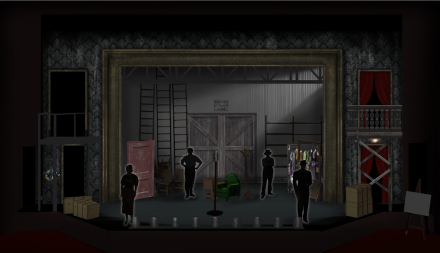
2024 Scenic Design by Jason Lajka -
The 39 Steps won the 2007 Laurence Olivier Award for Best New Comedy and two Tony Awards in 2008.
-
Surprisingly, it’s been speculated that parts of The 39 Steps are autobiographical. Richard Hannay is said to have similar qualities to one of Buchan’s friends.
For those that are new to theatre, longtime theatre-goers, or families, The 39 Steps is sure to entertain a variety of audience members. It’s not too early to purchase tickets. Don’t wait! Visit bard.org for more information.
Festival Congratulates LeGrand Andersen on Utah Theatre Association Award

The Utah Shakespeare Festival would like to personally congratulate Dr. LeGrand Andersen for receiving the Utah Theatre Association Lifetime Service to the Community Award, which was presented in January. Andersen was an integral part of the Festival for many years, specifically with past Playmakers productions, full-scale theatrical educational productions for children aged 5-17.
Executive Managing Director Michael Bahr worked closely with Andersen for nearly 20 years when he served as the Festival’s Education Director.
“As musical director––he was yin to my yang––‘Doc’ provided a rigor and structure to musical training. He is demanding and cultivated a high standard of performance with all students,” Bahr said.
Andersen has worked for the Festival as a performer, musical director, and a member of pit orchestras. Bahr noted that it has been a gift learning from and teaching with the “maestro extraordinaire.”
“Both Dr. Andersen and I believe that a ‘live orchestra’ is essential in theatre training,” Bahr continued. “Students who have performed under Dr. Anderson’s baton now understand how to gauge pitch, tempo, and the art of breathing with the orchestra and the audience as one group.”
About Andersen
Andersen has been involved with and passionate about theatre since he was in eighth grade. He pursued a career in music and education, teaching at Fresno City College.
“I was involved in theater in California, although my primary responsibility was with the choirs,” Andersen said.
He retired in 2000 and moved to Cedar City with his wife Mary Anne to be near the Festival and said that as theatre lovers, they couldn’t ask for anything more than living down the street from the Festival.
“My wife and I haven’t missed a play at the Festival in 30 years,” Andersen said. “My favorite play is the one I’m currently seeing, but the [2021 production] of The Pirates of Penzance was really good. I saw it five times.”
About Playmakers
Andersen was working on a show for Southern Utah University when Bahr discovered his work.
“Michael saw me and picked up a partnership that has been ongoing for 19 years,” Andersen said. “With Playmakers, Michael did the drama part and I did the music part. When we would choose a musical, I would conduct the orchestra or rescore the music to fit the voices that we had.”
As a former educator, the Playmakers program is important to Andersen for several reasons.
“We have to make new audiences, and have people that know what’s expected in theatre. . . so we can count on building audiences [with] Playmakers,” Andersen said. “But there’s also individual growth and learning by the kids, learning [valuable things] like to be on time and there are people counting on you, and that the audience is enjoying what you do.”
For 19 years, Andersen returned year after year because he enjoyed working with the kids.
“It was exciting to watch them learn and grow into their parts . . . it’s an important experience for a young person,” Andersen said.
Andersen’s daughter, Amy Morrey, is proud of her fathers work with Playmakers.
“He has helped countless schools with arranging music, creating minus tracks, and encouraging kids to be their best and achieve high levels of excellence,” Morrey said.
UTA Lifetime Service to the Community Award
Andersen was thrilled to receive the Utah Theatre Association award.
“My daughter Amy presented the award, as she has gone back through my life and had found things that were pertinent to the award. It’s always nice to have people say nice things about you,” Andersen said.
He was chosen to receive the award because of his commitment to the community and his years of service with Playmakers, along with his support of educators statewide.
“He can also be seen at many Festival rehearsals, sitting in the back eating ice cream and chatting with some of his biggest fans,” Morrey said.
Whether it’s eating ice cream at rehearsal, educating at summer camps, scoring music, or watching The Pirates of Penzance for the fifth time in a row, Andersen’s presence and work at the Festival has not gone unnoticed. The Festival would like to sincerely thank Andersen for his years of service to the organization and congratulate him on his recent award.
To enjoy the 2024 play lineup with Andersen and his wife this season, visit bard.org to purchase tickets.
The Month of Love: Romance in the 2024 Season

Our dear Festival patrons, happy February. In light of Valentine’s Day this month, we thought we’d highlight all things “love” and drama in our 2024 play lineup.
Ranging from the forbidden love of Anne Boleyn and Henry VIII, to the witty verbal sparring of fan favorites Beatrice and Benedick, to the all-encompassing love Henrietta presents in Silent Sky, our lineup features a variety of romance that everyone can relate to in some form.
The Taming of the Shrew
“I burn, I pine, I perish.” - Act 1, Scene 1
Tackling complicated themes on the social constructs of marriage and the patriarchy, Director Valerie Rachelle is returning to the Festival after directing the tooth-achingly sweet romance of Jane Austen’s Emma The Musical last season.
Following the storyline of complicated relationships, The Taming of the Shrew is teeming with the concept of love and its pursuits. In Rachelle’s director vision statement, she notes that the play can seem problematic for a contemporary audience, but “ultimately it is a comedy that can show us the flaws in the social construct that we still have today about gender roles within the institution of marriage.”
In regards to navigating the difficulty of these topics, Rachelle will use satire.
“We can laugh at the power struggle as long as we are all in on the joke together and the audience and [actors] of the play know this is a satirical comment on the flaws of the system,” Rachelle said.
On a lighter note, perhaps a viewing of 10 Things I Hate About You, the 1999 romantic comedy starring Heath Ledger, would be a fun way to prepare for the 2024 production of The Taming of the Shrew, as the movie is based off of the play.
The Winter’s Tale
“There rooted betwixt them then such an affection, which cannot choose but branch now.” - Act 1, Scene 1
This play explores different kinds of love, such as that between lovers, friends, and family members. The main romantic relationship in this Shakespeare play is between King Leontes and his wife Hermione, which tows the line between love and tragedy. Another important relationship is the friendship between Paulina and Hermione.
Full of extreme passion and jealousy, this play is a fiery representation of the madness into which love sometimes drives us. The complex story also tells of forgiveness, redemption, and ultimate sacrifice.
Henry VIII
“I beseech you now with all my heart, definitely to let me know your whole mind as to the love between us.” - Henry VIII to Anne Boleyn
The love in Henry VIII is tumultuous. Divorcing Catherine of Aragon and then marrying the younger Anne Boleyn, Henry and Anne’s love was taboo. However, it’s speculated that Boleyn’s wit drew the king to her, suggesting a genuine affection and love between the pairing.
After a string of divorces, is Henry VIII really a hopeless romantic or a politcal player? Perhaps he had six wives . . . but one true love.
The Mountaintop
“Shuga, shush. You just a man. If I was a man, I’d be starin’ at me too.” - Camae to MLK
While we find that Camae is much more than just a sassy hotel maid and fictional object of Martin Luther King, Jr.’s current attention, the flirting between the two serves to examine themes of mortality and duality. Camae’s self-confidence and humor is loveable. But ultimately, their interaction allows audience members to delve deeper into the complicated psyche and struggle of one of America’s best known leaders.
Much Ado About Nothing
“I love you with so much of my heart that none is left to protest.” - Act IV, scene 1
In our recent fun facts article on Much Ado About Nothing, we discussed how the characters Beatrice and Benedick have inspired many a couple. Some say Jane Austen took inspiration for her characters of Elizabeth and Mr. Darcy in Pride and Prejudice. Similarities between Shakespeare’s couple and Scarlett and Rhett in Gone With the Wind can also be seen in their fire and wit.
But, all is not fair in love and war, and much of the romance is twisted with confusion, miscommunication, and masquerading. What’s real and what isn’t? Come see this summer!
Silent Sky
“My heart is beating like a train. That’s your fault.” - Peter Shaw
Perhaps the most obvious romance in Lauren Gunderson’s play is the budding romance between Peter and Henrietta, although we won’t reveal how their relationship plays out. Peter’s exclamation of love is quite swoon-worthy:
“Your mind and spirit . . . I quite adore those things about you. And I don’t expect you to reciprocate immediately or at all, but I feared combusting if I didn’t tell you that you’ve been the brightest object in my day since we met. And we work with stars.”
But perhaps even more profound is Henrietta’s love for her work. Her deep desire to ask and seek the answers to the universe is moving and inspiring. Ultimately, Henrietta’s true love is the stars, and what an extraordinary love it is.
It’s not too early to get your tickets to join us for a season of love. Visit bard.org to purchase tickets and for more information about the plays.
Festival Welcomes New Guest Services Manager Sara Cram

The Utah Shakespeare Festival is thrilled to announce the newest addition to our residential staff, Sara Cram. As the new Guest Services Manager, Cram will be responsible for managing day-to-day guest services at the Festival and interacting with the community and Festival patrons.
“I am thrilled to join the Festival team,” Cram said. “I am looking forward to continuing to foster the positive and inclusive atmosphere that’s been created here, while also contributing to work with the community and build strong relationships.”
Originally from Tremonton, Cram made the move to southern Utah to attend what was then Dixie College. While there, Cram married and eventually moved to Cedar City. She and her husband have lived here for 19 years and began ushering at the Festival six years ago.
Cram has a history with theatre, and it was that draw to the fine arts that encouraged her to apply for the Guest Services position at the Festival.
“I was involved in theatre in high school and college. When I lived in St. George, I participated in [Dixie’s] costume shop and worked on the backstage production of Tuacahn… and then because I didn’t graduate from Dixie and chose to have a family instead, I’ve always had the thought of, ‘What if I had pursued a career in theatre arts?’ ” Cram said. “And this was the opportunity to answer that question.”
In 2018, Cram saw the Festival production of Big River, and knew she had to get involved with the Festival. In addition to volunteering with her husband as an usher, Cram brings her family to Festival plays.
Cram graduated with her bachelor’s degree in interdisciplinary studies from Southern Utah University in 2022. Her degrees of focus were psychology, women and gender studies, and communications.
Cram brings both educational and work experience to the Guest Services Manager role.
“All of my work experience has been [people-focused]. I’ve worked a lot with people, so it’s a natural progression for me to work in guest services,” Cram said. “I enjoy interacting with the general public, so it felt like a good next step.”
Cram is familiar with both serving the community and working on Southern Utah University’s campus, having recently worked as a Program Coordinator in the Community and Workforce Development Department.
“It was such a good environment and that absolutely prepared me for this position,” Cram reflected.
For Cram, serving as Guest Services Manager is a perfect fit, and the Festival couldn’t agree more. She looks forward to meeting and working with patrons, company members, and other guests.
This season, Cram is looking forward to expanding her horizons in theatre, especially eager to see the productions of The Mountaintop and Silent Sky.
For tickets and more information on the Festival’s 2024 season, visit bard.org.
Ten Fun Facts: What You May Not Know About Shakespeare’s Much Ado About Nothing

Welcoming first audiences on June 21, one of Shakespeare’s most popular comedies is a must-see! Directed this summer by long-time Festival favorite, Brad Carroll, here are some fun facts to prepare you for Much Ado About Nothing.
-
This will be the Festival’s ninth production of Much Ado About Nothing, the first being in 1965 and the most recent in 2016.
-
This is the first time the Festival will produce this play indoors, in the Randall L. Jones Theatre, bringing a fresh approach to a classic play.
-
Director Brad Carroll found design inspiration for this production from American Artist Maurice Prendergast. Painting in oil and watercolor, Prendergast created mosaic-like color and is associated with the art movement of Post-Impressionism.
-
Shakespeare also drew inspiration while writing the play. Similarities between the Claudio/Hero plot can be found from Novelle by Matteo Bandeo. Scholars also believe Shakespeare used Ludovico Ariost’s poem “Orlando Furioso.”

2024 Production Renderings. Costumes by Brenda Van Der Weil. Scenic Designs by Jason Lajka. -
Much Ado About Nothing contains more prose than any other Shakespeare play. Only about 25 percent of the play is verse.
-
Ever heard of the phrase, “curiosity killed the cat?” Shakespeare used this line in the play as well: “What, courage, man! What though care killed a cat?” Although an expression similar to our modern phrase first appeared in a play by Ben Johnson in 1598, Shakespeare seemingly made the phrase popular.
-
Historians aren’t sure when the play was first performed. Although it was written between 1598 and 1599, no public performance of record was found until 1613.
-
The comedic character of Dogberry in the play was written specifically for actor William Kempe. A member of Shakespeare’s troupe, he ironically left the group in 1599, before any recorded performance of the play.

2024 Production Renderings. Costumes by Brenda Van Der Weil. Scenic Designs by Jason Lajka. -
The comedic technique of “malapropism,” or the purposeful confusion of multisyllabic words, is sometimes referred to “dogberryism,” after the use of it by Dogberry in the play.
-
The verbal sparring between Beatrice and Benedick is one reason the play is so popular and is the model for witty lovers. Some say Jane Austen took inspiration for her characters of Elizabeth and Mr. Darcy in Pride and Prejudice. Parallels between Shakespeare’s couple and Scarlett and Rhett in Gone With the Wind can also be seen.
It’s not too early to purchase tickets! Visit bard.org to purchase tickets and for more information about the play. Don’t miss out on our study guides, where you can find a synopsis, character summaries, and several articles on the play.
Much Ado About Nothing Through the Years
The Utah Shakespeare Festival has put on eight previous productions of Shakespeare’s Much Ado About Nothing. This will be the first year that the play will be produced in the inside space of the Randall L. Jones Theatre.
The play hit Festival stages in 1965, 1973, 1981, 1987, 1995, 2003, 2010, and 2016. Enjoy these pictures of past productions!
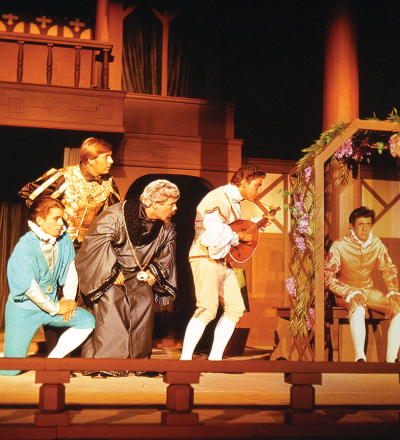
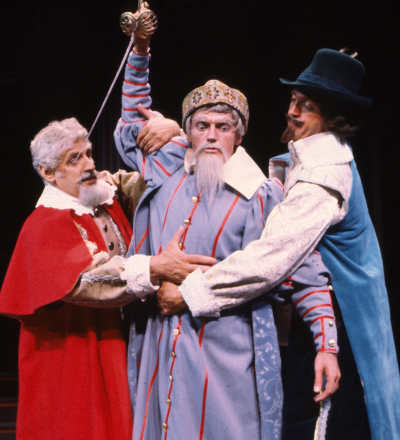


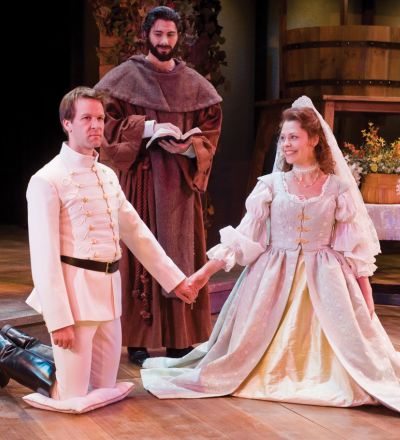
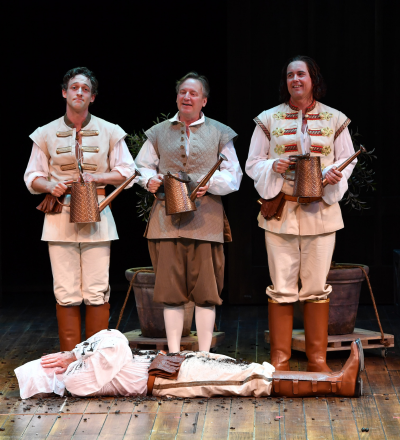
It’s not too early to purchase tickets! Visit bard.org to purchase tickets and for more information about the play. Don’t miss out on our study guide, where you can find a synopsis, character summaries, and several articles on the play.



